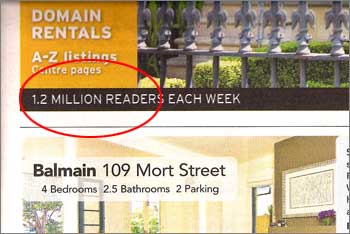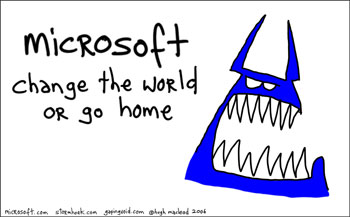There’s some great comments on yesterday’s piece about Microsoft. And there’s still time to add your thoughts before my dinner tonight. You know what to do.
How can Microsoft stop us hating them?
So what do you think of Microsoft, eh? No, really. I want to know.
I have to admit I’m not exactly a fan. I’ll explain why momentarily. But Microsoft is changing, or at least wants to change, and I’m finding it hard to shed old impressions.
The Blue Monster cartoon is part of this changing Microsoft. Its creator, Hugh MacLeod, intended it as a conversation-starter — what he calls a social object. Steve Clayton from Microsoft UK says they use it to help Microsoft start talking about its own process of re-birth.
I’m cynical when software companies claim grand goals like “changing the world”. That over-the-top rhetoric was central to the first dot-com bubble. Usually, the bigger the rhetoric the crappier the product. Still, I’m willing to listen.
Another sign of a changing Microsoft is my friend Nick Hodge, who sold me my first Mac back in 1985. Nick now works for the Blue Monster as an “enthusiast evangelist”, and represents how Microsoft is embracing blogging and a new culture of openness — and actually having conversations with people instead of talking at them.
But can Microsoft really change and, more importantly, convince us to believe them?
Not the cheapest
A client just told me, “You’re not the cheapest, but I like the way you work and I know I’ll always get a good result.” Chuffed. And yes, “cheapest” usually doesn’t mean “best”. “Cutting corners” or “skimping” is not the same as “value for money”.
Principles help win over panic
 “Everything looks like a failure in the middle,” warns Rosabeth Moss Kanter. Any new enterprise encounters roadblocks. As the obstacles multiply, the situation looks hopeless. That’s precisely when you need to hold onto your principles, your long-term view, to help get you past that panic. Read more at Long Views.
“Everything looks like a failure in the middle,” warns Rosabeth Moss Kanter. Any new enterprise encounters roadblocks. As the obstacles multiply, the situation looks hopeless. That’s precisely when you need to hold onto your principles, your long-term view, to help get you past that panic. Read more at Long Views.
Modern financial markets explained
This video explains it all. Thanks to Marc Andreessen for the pointer.
Domain: misleading advertising?

The Sydney Morning Herald‘s over-blown real estate section (right) claims 1.2 million readers each week. That’s misleading, surely?
According to Fairfax’s own circulation figures, the Saturday SMH gets 1,176,000 readers from a circulation of 364,000.
OK, rounded to two significant figures, I’m cool with that. But I reckon putting that 1.2 million figure on the cover of Domain is misleading — in the Trade Practices Act sense of the word — ‘cos it implies that the real estate ads get that many readers. I really, really doubt that.
The first thing many (if not most) readers do is fillet the paper, throwing out the classifieds-filled supplements. And if you look in the bins at any suburban railway station on a weekday, you’ll see them chock full’o unopened, unread Domain, Drive, MyCareer and all the other crap they don’t need.
So, Fairfax, misleading advertising? What’s the real readership of the real estate ads?

